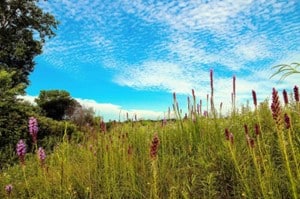
Photo credit: Jerry Newman
Briggs Wetland
Briggs is a 24-acre parcel of wet prairie and wetland (with artesian springs). Briggs was purchased from the Reorganized Church of Later Day Saints in 1994 by the Natural Land Institute of Rockford, Illinois. The buy was assisted through cooperative fund raising by the Prairie Bluff Chapter and a big grant from the Wisconsin Department of Natural Resources.
Briggs was transferred to TPE in 1996. We routinely burn Briggs Wetland, and skirmish the invasive aliens like buckthorn (Rhamnus cathartica) and Canada thistle (Circium arvense). We have about 4 acres of tilled field we are planting to prairie on the south side.
This property is considered difficult to hike; there are no trails on the prairie.
SITE STEWARDS
FRED FAESSLER
608-214-3203
ACCESS & DIRECTIONS
Briggs Wetlands lies on the west side of Brostuen Road between Beloit-Newark Road and Cleophus Road northwest of Beloit in Rock County, Wisconsin. State highways 11 and 213 are the nearest main arteries for visitors. There is no parking lot, but you can park along the east side of Brostuen Road. Access is by foot-traffic only. There are two springs near the sign on the east edge of the property. A wet prairie contains many tussock sedges (Carex stricta) which make hiking difficult.
Google Map
Description & Significance
The flora of Briggs Wetlands is highly diverse and includes typical wetland species.
An artesian spring emanates from a shallow, sandy-bottomed pool near the east edge of Briggs Wetland, and the rapid-running brook that leaves the pool is about 24-inches wide and flows west toward Raccoon Creek. This stream is very clear, and it never freezes, although nearest to the springs it is full of non-native watercress.
Among the conservation biologists who have studied Briggs Wetlands (mostly during the 1990s) were Prairie Enthusiast Rob Baller, Michael Jones and Rachel Cough of Natural Land Institute, UW entomologist Andrew Williams, Wisconsin Herbarium curator Ted Cochrane, Trish Roberts of The Nature Conservancy, and Richard Newsome of Beloit College.
Notable Plants
- marsh marigold (Caltha palustris)
- golden alexanders (Zizia aurea)
- meadow rue
- cotton grass
- mountain mint (Pycnanthemum virginianum)
- bluejoint grass (Calamagrostis canadensis)
- Turk’s cap lily (Lilium michiganense)
- prairie blazing star (Liatris pycnostachya)
- Riddell’s goldenrod (Solidago riddellii)
- turtle head (Chelone glabra)
- bottle gentian (Gentiana andrewsii)
- and at least 18 species of sedges.
Species Suggestive of a Fen Community
- Muhly grass (Muhlenbergia richardsonis)
- edible valerian (Valeriana edulis)
- star sedge (Carex echinata)
- Kalm’s lobelia (Lobelia kalmii)
Natural History
Briggs Wetland is part of a larger tract of wet prairie, sedge meadow, fen and shrubland along the East Fork of Raccoon Creek that has been designated a Wisconsin State Natural Area to recognize the quality and rarity of this natural community. Briggs Wetland contains a perennial bubbling artesian spring that flows over a sandy bottom a few hundred meters to the southwest, where this stream joins Raccoon Creek. The east fork is one of the few trout streams in Rock County, hosting native brook trout subject to catch & release regulations.
Waterfowl that nest in the Raccoon Creek corridor include Wood Ducks, Mallards and Blue-Winged Teal. Other migratory birds found in the wetlands are Green-Winged Teal, Gadwall, Widgeon, Kingfisher, Kingbird, Sedge Wren, Swamp Sparrow, Willow Flycatcher, Northern Harrier, Common Yellowthroat, Virginia Rail, Sora Rail, Great Blue Heron and Sandhill Crane.
Protected land nearby Briggs Wetland is 28 acres to the northwest owned by the Green Rock Audubon Society and 33 acres to the southwest owned by Beloit College (Newark Road Prairie) that is a dedicated State Natural Area.
Usage Policies
Allowed:
- Hiking
- Hunting (all species; no permit or reservation required)
- Birding
Not Allowed:
- ATVs, Snowmobiles, or other Motorized Vehicles
- Camping
- Horseback Riding
- Picnics
Ownership History
According to a historical plaque on the east side of Brostuen Road, the site has special religious significance to the Church of Jesus Christ of Latter-Day Saints and is named in honor of Jason W. Briggs (1821-1899), an early follower of the religion that was founded in 1830 by Joseph Smith Jr. in New York. After Smith’s death by a mob in 1844 in Illinois, the leadership was contested.
“On November 18, 1851, while praying for guidance (on the prairie near this site) Briggs received a startling revelatory experience. His record of that experience became the foundation of what soon came to be called the New Organization. The Wisconsin branches at Newark, Beloit, Waukesha and Yellow Stone, together with others in Northern Illinois united to reorganize the church in 1852. Briggs and other interim leaders held the scattered groups together through the rest of the 1850’s. Several early conferences of the church were held on a campsite around a spring across the road from this site.”
By the 1990s the church had re-purchased the Briggs farm on both sides of Brostuen Road. In 1994 the church reduced the sales price of this wetland to a non-profit conservation group, the Natural Land Institute of Rockford, Illinois, with the stipulation that it be named Jason Briggs Wetland after the patriarch of that reorganized branch of the LDS church. In December of 1996 the Prairie Enthusiasts bought the property from NLI, with one-half of the appraised value paid from the Wisconsin Nelson-Knowles Stewardship Fund.
Management Activities by the Prairie Enthusiasts
Recent management activities by Fred Faessler and other volunteers have focused on removal of buckthorn and willows from the areas south and east of the wetlands, which are remarkably free of brush and weeds, and the creation of a permanent firebreak. Prescribed burns have been infrequent, with some portions burned in 1995, 1996, 2000, 2007 and 2011.

